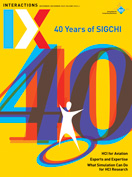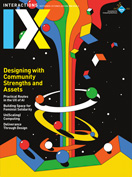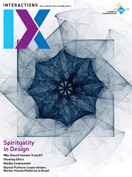Authors:
Shital Desai, Pablo Vivanco, Deborah Fels
The community of Jane and Finch (also known as Black Creek) is a high-density, multicultural, low-income neighborhood in northwest Toronto, Ontario. Home to people from more than 70 countries, with 100 languages spoken [1], the area has been described as having more immigrants, more single-parent households, higher rates of unemployment, a higher percentage of the population without a high school diploma, and higher rates of low-income families than the rest of Toronto. The Toronto City Summit Alliance's Strong Neighbourhoods Task Force identified the Jane and Finch neighborhood as one of 13 priority neighborhoods in the city.
→ Emergency situations such as Covid-19 push seniors in marginalized communities into social isolation.
→ The online programs at JFC lacked the social engagement and connection that seniors experienced with in-person activities before the pandemic.
→ A service platform for active aging in seniors should support "successful aging," creation of networks, extension of connections outside JFC, and peer mentoring.
Seniors residing in the Jane and Finch neighborhood face many barriers to survival, including a lack of affordable housing, the cost of capital repairs and essential maintenance, the rising cost of living while household incomes remain low, and deteriorating health and neglected well-being [2]. These barriers have forced many older adults into social isolation, resulting in higher levels of stress compared with other communities and neighborhoods [3]. Community centers such as the Jane Finch Centre (JFC) assist seniors in gaining access to information (healthcare, recreation, events, legal, etc.) and services through connections to local healthcare providers, legal aid workers, and social workers. They also provide opportunities for seniors to engage in activities that help promote active aging [4].
 Transitioning to Online Programs During the Covid-19 Pandemic
Transitioning to Online Programs During the Covid-19 Pandemic
The Covid-19 pandemic disrupted the everyday lives of seniors, forcing most to self-isolate in their homes and resort to services available online [5]. Community centers had to shut down some of their day programs for seniors and move the rest online, to Zoom. This transition to online programs was not easy for seniors at the JFC. They did not have access to laptops and smartphones, and most did not have WiFi at home. The JFC collaborated with the Toronto Public Library on a laptop loan program to provide seniors with computer and smartphone access for a limited time. Some seniors were provided with phones (smartphones or landline phones) and a WiFi connection or landline connection through government funding and donations from organizations. Because most seniors at the JFC lacked experience using computing resources and Zoom for remote communication, they were trained in the use of technologies to attend the JFC programs online. The experience of these online programs, however, was not the same as in-person ones. Seniors expressed their desire to use the technologies for other purposes, such as watching videos, looking up recipes, and talking to loved ones. The most critical aspect of in-person programs that the seniors missed in the online programs was the social engagement and the activities they did together during those programs.
"I miss meeting people, talking to them and having lunch with them." — FEMALE, SPANISH, 65 YEARS
In this article, we discuss the motivations of seniors at the JFC to attend programs at the center and propose a design intervention for seniors in marginalized demographics in emergency situations such as the pandemic.
 Experiences of Seniors with JFC Programs
Experiences of Seniors with JFC Programs
We conducted a study with seniors and staff at JFC to learn about the experiences of seniors with the center's programs before and during the pandemic. Factors contributing to continuous engagement of seniors with the center's programs include the following:
Social connectedness. Due to the pandemic, seniors in the Jane and Finch community experienced increased feelings of social isolation and loneliness. Before the pandemic, seniors at the JFC enjoyed a sense of family and meaningful relationships with their peers and program managers. To maintain social connectedness during the pandemic, seniors continued attending the center's programs online, but the experience was not the same. Seniors had enjoyed lunches and potlucks together, as well as excursions and other activities, which triggered conversations about where they grew up, favorite recipes, and other topics.
JFC activities. Before the pandemic, seniors participated in face-to-face on-site programs that ranged from dance and exercise classes to learning about new recipes and gardening. Due to pandemic-related restrictions, the programs were moved online, to Zoom. Seniors expressed a desire to continue attending these programs despite their new format. While seniors were motivated to attend for health reasons, their primary motivation was the fun and enjoyment that the activities brought to their lives.
Autonomy and being in control. The transition to online programs was facilitated by a technology-support manager who remotely set up Zoom for the seniors before the start of each program. Some seniors wanted more control—to be able to set up Zoom by themselves and use technology for activities other than attending the programs (listening to music, watching videos, searching for recipes on YouTube, emailing, social media, online games, connecting with family, attending live mass and other religious events, organizing picnics to the local park, etc.).
Learning new technology. Most seniors at JFC do not have access to technology and the infrastructure to use it (e.g., WiFi). They were introduced to computing resources such as laptops, smartphones, and Zoom for the first time. As the pandemic forced JFC programs to go online, it was imperative for seniors to learn how to use technologies unfamiliar to them. Some of the barriers to learning new technology include lack of formal training in technology use, lack of confidence in learning new subject matter, lack of familiarity with technology features, and age-related challenges.
Access to information. One of the motivating factors to attend JFC programs is to receive information on finance, healthcare, settlement services, and changes to immigration rules presented by professionals. Peers are also a source of information on, for example, shopping discounts and recreational opportunities. The center's programs also provide seniors a platform to access logistical information through their program managers that could support their active aging, such as healthcare checkups, vaccinations, and transportation.
Ongoing technical support. To use technology and attend JFC programs online, seniors require ongoing technical support and training [6]. They received technologies and infrastructure, such as WiFi, laptops, and smartphones, from the center through donations from the Toronto Public Library and other benefactors. Seniors were provided training on technology use, which included topics such as avoiding scams and navigating social media. However, to use this technology beyond JFC programs for activities such as watching YouTube videos and connecting with program managers, peers, and others, ongoing technical support is necessary.
Opportunities to engage. For seniors, the JFC is a place to connect socially and engage in community programs through volunteer activities, such as providing interpretation services for the center's programs and supporting program managers in coordinating and facilitating the day programs. In some cases, this also led to paid employment for the seniors.
 Design Proposal for JFC in Emergency Situations
Design Proposal for JFC in Emergency Situations
The main challenge that the JFC and its seniors faced during the Covid-19 pandemic was tackling social isolation while maintaining social distancing. Factors such as peers, program managers, food-sharing events (e.g., potlucks), and conversations contributed to seniors' engagement with the programs at JFC before the pandemic. Seniors would take these connections and conversations outside the program, which often led to other possibilities for engagement. For example, new connections developed at JFC programs enabled a senior to create a cycling group whose members would bike through downtown Toronto. Conversations resulted in excursions to places of interest, such as Niagara-on-the-Lake and museums. With new knowledge and experiences, seniors could then suggest new programs and activities to the program managers. Having autonomy and control over the programs and technology is important not only for the continuous engagement and participation of seniors in JFC programs but also for their health and well-being.
"I ride my bike through the streets of Toronto. Others join me too. She [the program manager] helped us arrange for transport to go on excursions [before the Covid-19 pandemic]." — MALE, GUJARATI, 59 YEARS
Thus, in times of national emergencies such as Covid-19, a service platform designed for supporting seniors in marginalized communities such as Jane and Finch should cater to the following requirements:
Aging successfully. The seminal work of Jan Baars on critical gerontology helps conceptualize eldercare and senior services [7]. Baars critiques modern culture, pointing out how it extends life span yet accelerates aging, emptying life of all meaning in the process. In this efficiency-driven paradigm, seniors are stripped of their identity and dignity; they are regarded only as "objects of care." This "care" involves partitioning time into measurable units of age and corresponding ailments and then applying a regimen of diets, medication, and care to prolong life.
In response, Baars calls for elder/senior care and services to be creative, to design care that is "embedded in the life of persons with dignity." This requires the public to understand seniors as socially located, vulnerable, unique individuals ready to live possible futures filled with perils and promises, rather seeing them through static categories and criteria (e.g., "wisdom" or even "age appropriateness"). Toward this end, Baars emphasizes the need to move away from approaches that seek to control one's life. Instead, we should focus on an "authentic living" approach, which is defined as living in the moment, experiencing connectedness to others, and creating self-narratives. These narratives help shape our personal identity. Compared with other narratives, they enable reflection that makes sense of life. Therefore, service platforms should be designed to support successful aging in older adults so that they are able to continue participating in lifelong activities like hobbies and sports. As mentioned earlier, one senior who attended JFC in-person programs described how those programs allowed him to organize bike trips and excursions with his peers in and around Toronto.
Creation of networks. Service platforms should allow seniors to share and access information with peers attending JFC programs. Seniors appreciate the information-rich presentations and seminars at the center. Older adults shared information and news about the Jane and Finch neighborhood with their peers when they attended the in-person programs before the pandemic. One senior explained how they shared information about discounts at the local shops and exchanged coupons. Program managers provided information about governance policies, vacancies in community housing, settlement services, and immigration. Older adults would change groups and community centers as program managers moved due to work assignments. This movement across community centers and groups facilitated increased social connection and engagement.
Extending connections. The social engagements among seniors before the pandemic included sharing home-cooked food to celebrate festivals and events, going on excursions, and exchanging personal stories and narratives. Although technology and support from the JFC has allowed seniors to continue attending online programs and seminars, attendees did not initiate conversations and connections with their peers like they did when programs were in person. Some of the reasons that seniors provided for this decreased engagement were uncertainty about scheduling Zoom calls, the intrusiveness of landline phones, lack of access to contact information, and lack of motivation. One senior described how volunteering for programs at the JFC gave her an identity and allowed her to engage with others. A service platform for seniors should facilitate these social experiences and opportunities for secondary benefits.
Peer mentoring. The service platform for JFC seniors should allow them to create and share new information and content, such as audiovisual media content and podcasts, in order to mentor their peers. For example, seniors attending in-person programs before the pandemic taught their peers new recipes, languages, games, technology, and repair work. They also provided support with filling out administrative forms (e.g., filing tax returns) and planning holidays and excursions. In-person setup also provided a venue for older adults to share their personal stories. The service platform should thus afford the creation of new media content to mentor others in the program.
Thus, the service platform for seniors in the community will allow them to take on the roles of leader, creator, and peer (Figure 1).
Leaders initiate new programs, activities, and avenues for social engagement based on their own experiences and knowledge or information acquired. Creators develop new resources such as media content, publications, and podcasts for their peers to learn skills that will allow them to engage with the JFC and other activities. Creators could also search for existing resources, such as YouTube videos, to mentor others. Peers are consumers of the resources, programs, and activities. They are also responsible for sharing content and information. Seniors could take on any of these roles, allowing them to take control of the platform and the programming in general.
JFC programs provide avenues for seniors to socially connect with one another not only for the duration of the program but also outside JFC. When the programs were moved online during the pandemic, seniors at the center could participate in them through donated computing resources and Zoom, but technology could not replicate the experience of attending the programs in person. Thus, a service platform is required for seniors to continue to engage and connect while attending the JFC programs. Such a platform should support successful aging, the creation of networks, the extension of connections outside JFC, and peer mentoring. Seniors could take the role of leaders—contributing to the development of new programs, creators (developing resources and supporting their peers), and peers (consuming the programs and resources). People could change their roles anytime depending on their choice, knowledge, and skills. This truly human-centric platform could offer autonomy and opportunities to age gracefully and actively.
This project has received funding from a TD (Toronto Dominion) Community Engagement Centre grant. We are grateful to the staff and seniors at the Jane Finch Centre for their support of and participation in the study. We would like to acknowledge and thank Vjayanthi Janakiraman, who carried out data coding and helped create the diagram representing the framework.
1. Canadian Broadcasting Corporation Docs. Mr. Jane and Finch. CBC Docs, 2007; https://www.cbc.ca/cbcdocspov/episodes/mr-jane-and-finch
2. Descary, L. The fight for housing justice. Spring. Jun. 3, 2019; https://springmag.ca/the-fight-for-housing-justice
3. Islam, F. Jane-Finch Seniors: Stressed out. Jane-Finch.com, 2011; http://www.jane-finch.com/articles/files/seniorsreport.pdf
4. The seven dimensions of wellness. International Council on Active Aging, 2021; https://www.icaa.cc/activeagingandwellness/wellness.htm
5. Cohen, M.A. and Tavares, J. Who are the most at-risk older adults in the COVID-19 era? It's not just those in nursing homes. Journal of Aging & Social Policy 32, 4–5 (2020), 380—386.
6. Desai, S., McGrath, C., McNeil, H., Sveistrup, H., McMurray, J., and Astell, A. Experiential value of technologies: A qualitative study with older adults. International Journal of Environmental Research and Public Health 19, 4 (2022); https://doi.org/10.3390/ijerph19042235
7. Baars, J. Aging and the Art of Living. JHU Press, 2012.
Shital Desai is director of the Social and Technological Systems Lab and an assistant professor in interaction design at York University in Toronto, Ontario. Her research focuses on accessible interaction design for older adults and people with dementia. [email protected]
Pablo Vivanco is director of programs and community development at the Jane Finch Centre. Before joining the center, he headed a 24-hour media organization based in Ecuador. He also worked at Toronto City Hall as executive assistant to a city councillor. Vivanco holds a B.A. in history and Latin American and Caribbean studies, as well as an M.S. in environmental studies with a planning diploma, both from York University. [email protected]
Deborah Fels is a professor in the Ted Rogers School of Information Technology Management and director of the Inclusive Media and Design Centre at Toronto Metropolitan University. Her research interests include inclusive design, access to media and technology for people with disabilities and older adults, and inclusive business. [email protected]
©2022 ACM 1072-5520/22/07 $15.00
Permission to make digital or hard copies of all or part of this work for personal or classroom use is granted without fee provided that copies are not made or distributed for profit or commercial advantage and that copies bear this notice and the full citation on the first page. To copy otherwise, to republish, to post on servers or to redistribute to lists, requires prior specific permission and/or a fee.
The Digital Library is published by the Association for Computing Machinery. Copyright © 2022 ACM, Inc.








Post Comment
No Comments Found